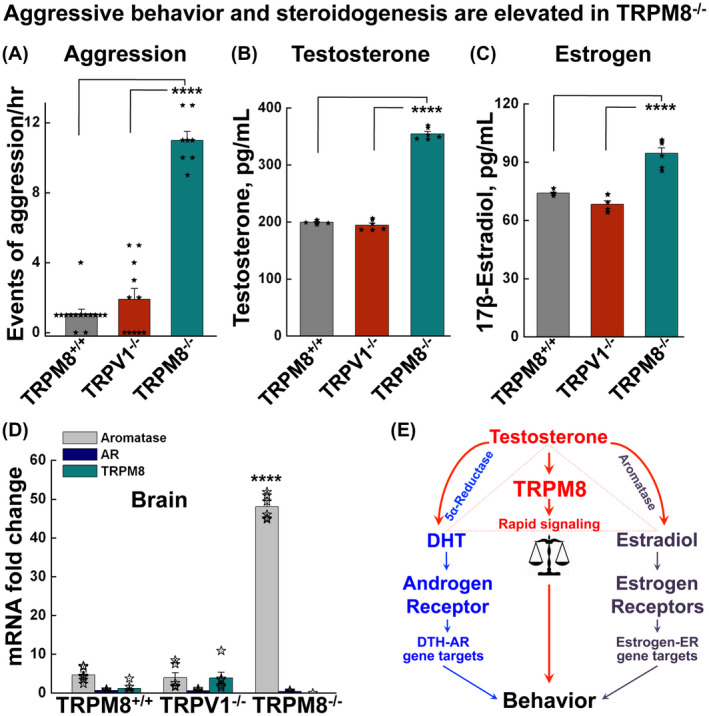Figure 2.

TRPM8−/− mice show increased aggressive behavior and elevated serum testosterone levels. A, the aggression of male animals was assessed as number of attacks for TRPM8+/+, TRPV1−/−, and TRPM8−/− mice as mean ± s.e.m. of at least 12 experiments (one conspecific pair in each experiment). P = .208 for TRPM8+/+ vs TRPV1−/−; P = 6.195 × 10−14 for TRPM8+/+ vs TRPM8−/−; and P = 5.747 × 10−9 for TRPV1−/− vs TRPM8−/−. B, serum testosterone concentrations determined by ELISA. Data are mean ± s.e.m., for males of the TRPM8+/+ (n = 6), TRPV1−/− (n = 6) and TRPM8−/− (n = 6) mice. P = .315 for TRPM8+/+ vs TRPV1−/−; P = 3.699 × 10−5 for TRPM8+/+ vs TRPM8−/−; and P = 6.586 × 10−5 for TRPV1−/− vs TRPM8−/−. C, serum 17β‐estradiol concentrations determined by ELISA. Data are mean ± s.e.m., for males of the TRPM8+/+ (n = 6), TRPV1−/− (n = 6), and TRPM8−/− (n = 6) mice. P = .262 for TRPM8+/+ vs TRPV1−/−; P = 1.15 × 10−6 for TRPM8+/+ vs TRPM8−/−; and P = 4.5 × 10−5 for TRPV1−/− vs TRPM8−/−. D, mRNA levels determined by quantitative RT‐PCR for aromatase, androgen receptor, and TRPM8 in brains of the TRPM8+/+, TRPV1−/−, and TRPM8−/− male mice (n = 4 each). All probes were normalized to glyceraldehyde 3‐phosphate dehydrogenase (GAPDH). P = 2.96 × 10−7 for TRPM8+/+ vs TRPM8−/−, and P = 2.25 × 10−8 for TRPV1−/− vs TRPM8−/− of aromatase. Statistical significance was evaluated using one‐way ANOVA test. E, schematic illustration of behavioral regulation by testosterone and its metabolic products, dihydrotestosterone (DHT) and estradiol. Testosterone activates rapid signaling through TRPM8 and its products induce genomic pathways through nuclear receptors, with DHT acting at androgen receptor (AR) and estradiol at estrogen receptors (ERs). Testosterone is converted to DHT by 5α‐reductase and estradiol by aromatase
